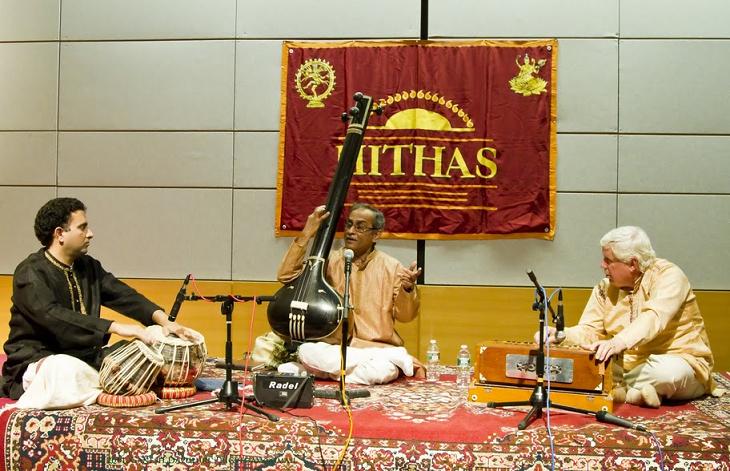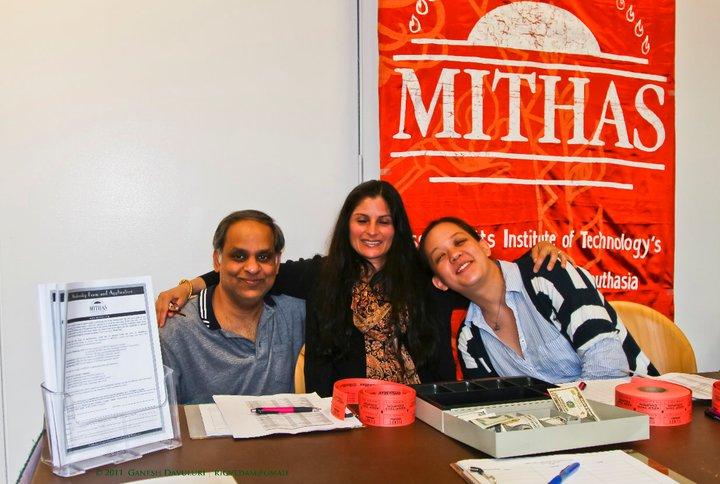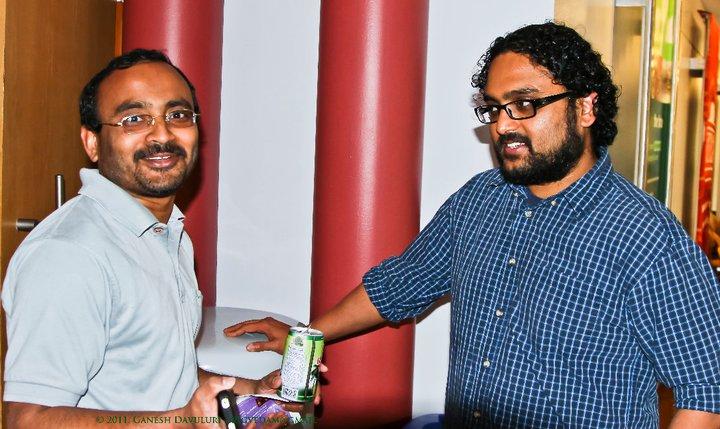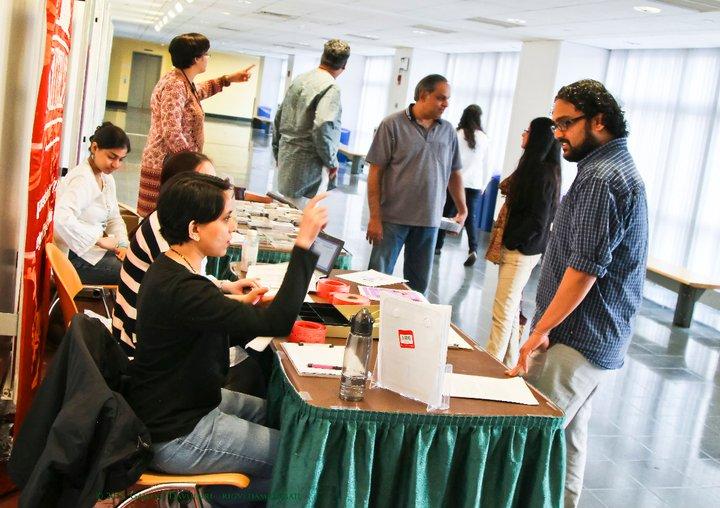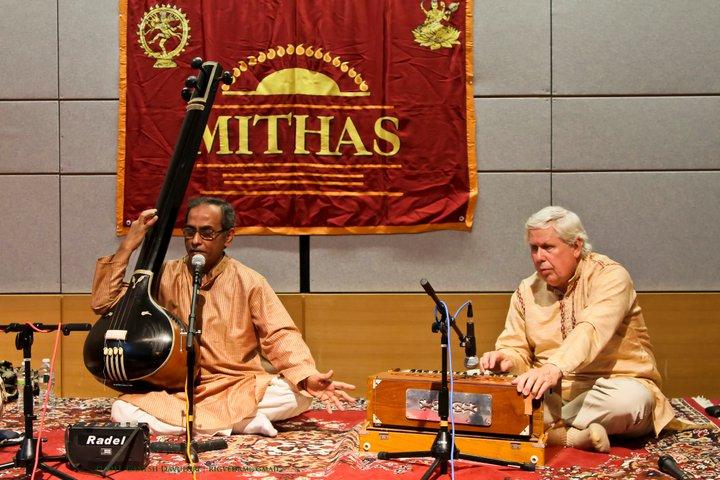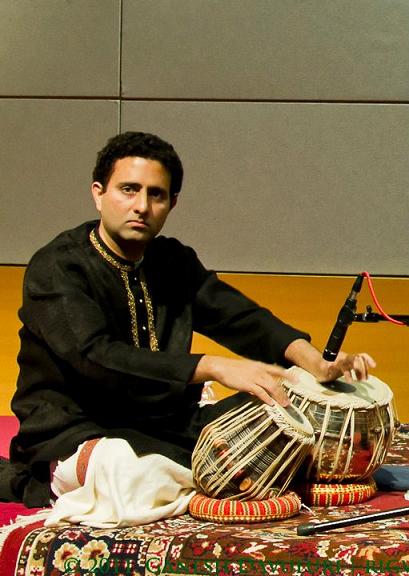Contribute
| MITHAS Presentation – A Melodious Hindustani Classical Music Recital By Dr. Ujjal Banerjee |
Suchita Rao
05/17/2011
On a rainy evening soaking Boston and Cambridge with thundershowers, Dr. Ujjal Banerjee presented a wonderful Hindustani classical music concert for MITHAS at Wong Auditorium on Saturday evening, May 7, 2011. Opening with an in-depth presentation of Raag Shuddh Kalyan, consisting of vilambit khyaal “Karam Karo†set to 14 beat cycle Jhoomra taal, popular drut composition “Mandar Baajo†set to medium tempo 16 beat cycle teentaal and followed by a Ustad Amir Khan taraana composition, Dr. Banerjee brought out essential nuances of the raga through the use of gliding ornaments “meends†and symmetrical phrases in his alaap development that matched the ornamentation in the construction of the musical compositions.
A seasonal raga Basant composition set to medium tempo 16 beat cycle teentaal followed raga Shuddh Kalyan. “Phagwa brij dekhan ko chalo ree†showed a variety of impressive sargam and aakaar tans. “I really liked the way he was composing on the spot on stage. His creativity was amazing†said Anuradha Yammunuri, a member of the audience.
Dr. Banerjee presented a contemplative khyaal in raga Abhogi Kanhra set to 10 beat cycle jhaptaal after the intermission. “Charan ghar aaye†brought out sad emotion (bhaava) and the drut composition “Laaj rakh leejay mori†set to fast 12 beat cycle ektaal had a variety of powerful tans. To celebrate the thunderstorms and rain showers, Dr. Banerjee presented a khayal in raag Gaud Malhar “Balmaa bahaar aayee†set to medium tempo 16 beat cycle teentaal based on a request from a member of the audience. He concluded with a melodious thumri “Mitwaa maanayna†in raga Mishra kaafi. He was ably accompanied on harmonium by Dr. George Ruckert and on tabla by Shri Harshal Tole. Harshal Tole’s “laggi†segment towards the end of the thumri was particularly enjoyable.
“I loved the concert. The main artist and his accompanists – all three did a great job. I felt an emotional connection to all of the music presented, especially the last item – Mishra kaafi thumri.†said Michael Fisch, another member of the audience.
Dr. Banerjee belongs to Indore Gharana of music started by Ustad Amir Khan. Ustad Amir Khan’s classical singing has been celebrated for its intellect and intricacy. Some of the essential characteristics of the gharana include
• Use of all three octaves for raga elaboration
• Clarity in pronounciation of lyrics of the composition
• Introduction of sargam(solfege syllables) alaaps during development of slow melodic khyaal.
• Use of fast phrases such as murkis to complement the tranquil and slow phrases in alaaps
• Repetition of phrases used during elaborating raga in slow tempo khyaal in the following drut khyaal presentation to re-inforce key phrases of raga in the mind of listeners
• Jumps between notes of three octaves in addition to systematic note by note development of alaaps and taans in a single octave
• Even voice projection especially in upper octave
Dr. Banerjee’s erect sitting posture with the taanpura balanced on his lap, his meditative stance, subtle acknowledgement of support of accompanying artists and his smooth flowing, melodious singing reminded listeners of the legendary Ustad Amir Khan.
Dr. Banerjee answered 10 questions in a post-concert interview.
1. Does the tradition of Hindustani music run in your family? At what age did you start learning to sing?
-Yes it runs through generations on my mother’s side. I started singing (they say) even before I started talking; I started learning from my mother at a tender age.
2. What forms of music have you been most attracted toward? Did you have a great musician as your "ideal"? What attracted you to his/her music?
- Although I learned many forms of music practiced in North India and Bengal, I was attracted mostly to Khayaal. My ideal is the late Ustad Amir Khan, because of the distinctive emotions he was able to evoke.
3. What Gharana do you belong to? How would you describe the music of your Gharana? What features in your opinion make the music of your Gharana stand out?
- Indore Gharana. This Gharana has all the nuances of Hindusthani Classical Music, yet the patterns are full of unpredictability. This Gharana stands out because of its nuances and apparent simplicity which results from a combination of Riyaz (practice) and Riyazat (thinking).
4. What were the names of your music teachers? What did you learn from each of them?
- Pandit Krishnadas Ghosh: taught me the basics and development of a Raga
- Pandit Usharanjan Mukherjee taught me how to present a Raga
- Pandit Srikant Bakre introduced me to the Amir Khan’s style of rendition
- Pandit Kamal Banerjee, my present Guru, is constantly refining my skills with inputs on logic behind Amir Khan’s style of rendition
5. How does one increase one's capacity to imagine and create new ideas in developing khayal music? How long did it take you to develop your own creative abilities?
- Thinking, listening and practicing in a logical way. It took me more than 25 years to develop my style in line with this Gharana. It is still evolving in newer dimensions with the help of my Guru.
6. You hold a PhD in Chemistry. How did you balance your interest in music with academics? Did you ever consider taking music as a career? Are you a full-time musician now?
- Musical and academic pursuits are complementary and in some ways similar. So balancing both sides becomes easier if one has passion for both. On top of that, I got all encouragement and support from my family. In India it is always a risk to take music as career. I did not take that risk but now 75% of my professional time is reserved for music.
7. I understand that you lived in the Boston area for several years before going back to India. Do you feel any change in the musical climate in Boston? Is the Classical music scene back in Kolkata more vibrant? Do you see evidence of upcoming/emerging talent in Hindustani Classical music in India?
- My wife and I came with a Green Card and after a short while decided to go back, to live in a city which is always vibrant with fine art and culture which include Hindusthani classical music. There are a quite a few potential Hindusthani classical musicians who are coming up fast in India.
8. Could you describe a moving incident in your musical career? Did the incident prompt you to change your outlook/thinking in any way?
- It was when a lady in the audience came up to me after my rendition of Raga ‘Malkauns’to say that the auditorium was now reverberating with the ‘sur’of Malkauns. I realized that I could also create an atmosphere appropriate for a Raga and started believing in my creativity.
9. Have you had opportunities to interact with peers and discuss classical music with them? How has the interaction helped you and how have you helped your peers grow in music?
- I do that often with peers. It is very important to look always for the positive aspects and share, even when a particular rendition does not appeal. That enriches the repertoire.
10. You teach Classical music to underprivileged children. Do you teach anybody and everybody or only those with musical ability? Do the students understand and get our musical concepts? Do they enjoy singing? How do you like teaching music?
- I teach anybody who is interested. All may not be able to sing. But we also need a receptive audience! Of course for these children, it has to start from their level of understanding! Even then a few opt out of the singing class! I try to emphasize that classical music is not alien as most music emanate from an acceptable, pleasing combination of notes. Then they start enjoying patterns created by combination of notes. Teaching classical music is challenging but becomes rewarding when the students are able to reproduce what has been taught.
Thank you, Dr. Banerjee.
Thank you, Shuchita.
You may also access this article through our web-site http://www.lokvani.com/
